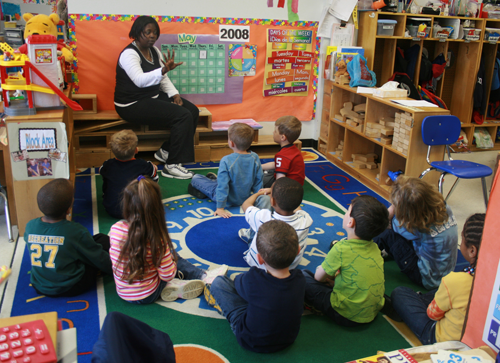Nov 03 2014 Weinberg Early Childhood Center and Library opens in East Baltimore
Case study update: Continued cross-sector collaboration brings revitalization to E. Baltimore
 Last month was the grand opening of the Weinberg Early Childhood Center (ECC) in East Baltimore. The ECC, located in the Elmer A. Henderson: A Johns Hopkins Partnership School (Henderson-Hopkins School) is part of an ambitious community revitalization and education initiative profiled in a recent Intersector Project case study, “Building Centers for Early Childhood Education in East Baltimore.”
Last month was the grand opening of the Weinberg Early Childhood Center (ECC) in East Baltimore. The ECC, located in the Elmer A. Henderson: A Johns Hopkins Partnership School (Henderson-Hopkins School) is part of an ambitious community revitalization and education initiative profiled in a recent Intersector Project case study, “Building Centers for Early Childhood Education in East Baltimore.”
The Early Childhood Center is a 30,000-square-foot facility that will not only provide resources for children from birth to age five, but also serve as a family support center with health and wellness programing for family members and the larger community.
“This is a great opportunity for a neighborhood that needs these opportunities badly,” said David W. Andrews, Dean of the Johns Hopkins School of Education. “When you see the number of young children in the neighborhood who need the type of support we’ll be able to provide, it’s very fulfilling for all of us.”
This month also marks the opening of a library in the Henderson-Hopkins School, as well as three others in Baltimore City Public Schools, as part of the Baltimore Library Project. This multi-year, collaborative effort brings together community stakeholders, government partners, and financial support from the Weinberg Foundation to design, build, and staff new or renovated libraries in schools across Baltimore. With 12 libraries scheduled to be completed by 2015, and 24 transformations expected in total, the Library Project unites cross-sector partners to achieve a shared vision of a revitalized community.
The success of Henderson-Hopkins and ECC is instrumental to the success of the mixed-income neighborhood that East Baltimore Development, Inc. (EBDI) is trying to create — a “revitalized, re-energized, and rebuilt East Baltimore.” While each partner in the collaboration will have different measures of success, the key is that the various priorities for success are not mutually exclusive. This is a tool The Intersector Project’s Toolkit refers to as Share a Vision of Success, the agreement on a set of project goals and ideal outcomes that clarify the mission and priorities of the collaboration.
Whether individual partners came to the table for academic or economic development purposes, the success of student learning remains the critical factor for everyone’s definition of the success of the project. The goal of the school is to “pursue the most contemporary, effective approaches to meeting the needs of students, their families, and the community,” said Andy Frank, Special Advisor to the President on Economic Development at Johns Hopkins University. Through a holistic approach to education, including physical and social development as well as academic achievement, the school’s success was a rallying point for partners from each sector.
